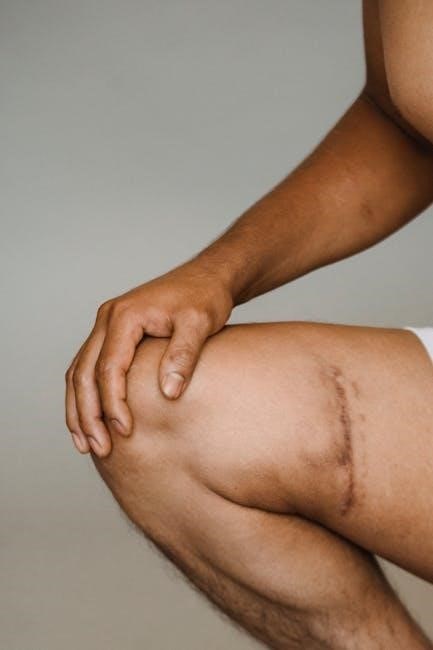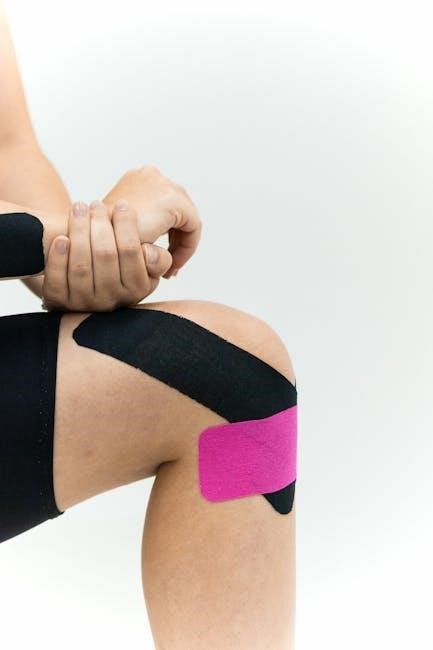How to Apply KT Tape for Knee Support
Applying KT Tape for knee support involves preparing the skin‚ ensuring it is clean and dry. Place the tape without stretching‚ starting from the anchor point below the knee. Apply gentle pressure for optimal adhesion‚ following the natural muscle and tendon paths. This helps provide stability and pain relief.
- Start with an anchor strip below the knee.
- Apply the tape along the muscle or tendon.
- Finish with another anchor to secure the tape.
Proper application enhances support and reduces discomfort during activity.
Kinesiology tape‚ commonly known as KT Tape‚ is a versatile and widely used tool for providing knee support and relief from pain. Initially developed for therapeutic purposes‚ KT Tape has gained popularity among athletes‚ physical therapists‚ and individuals seeking non-invasive solutions for knee discomfort. Its elastic properties mimic the flexibility of human skin‚ allowing for a full range of motion while providing stability and support.
The tape works by lifting the skin slightly‚ which reduces pressure on pain receptors and promotes blood flow. This makes it an effective option for addressing injuries like runner’s knee‚ tendonitis‚ and ligament sprains. KT Tape is also water-resistant and can be worn for several days‚ making it a convenient solution for ongoing support.
- Popular among athletes and healthcare professionals.
- Provides support without restricting movement.
- Can be used for both prevention and rehabilitation.
With proper application techniques‚ KT Tape can enhance knee stability‚ reduce discomfort‚ and accelerate recovery. This guide will walk you through the essential steps and tips for applying KT Tape effectively.
Benefits of Using KT Tape for Knee Pain Relief
Kinesiology tape‚ commonly known as KT Tape‚ offers numerous benefits for knee pain relief‚ making it a popular choice among athletes‚ physical therapists‚ and individuals seeking non-invasive solutions. One of the primary advantages is its ability to provide support and stability to the knee without restricting movement‚ allowing for a full range of motion. The tape is designed to reduce pain and inflammation by lifting the skin slightly‚ which decreases pressure on pain receptors and promotes blood flow to the affected area.
KT Tape is particularly effective for addressing common knee injuries such as runner’s knee‚ tendonitis‚ and ligament sprains. Its elastic properties mimic the flexibility of human skin‚ ensuring comfort and durability. Additionally‚ the tape is water-resistant‚ making it suitable for use during physical activities‚ and can be worn for several days‚ providing continuous relief. This non-invasive solution is also cost-effective and widely available‚ offering a practical alternative to braces or other supportive devices.
By enhancing stability‚ reducing discomfort‚ and accelerating healing‚ KT Tape serves as a valuable tool for both the prevention and rehabilitation of knee-related injuries.
Preparing Your Skin for KT Tape Application
Proper skin preparation is essential for optimal KT Tape adhesion and effectiveness. Begin by ensuring the skin is clean and dry‚ free from lotions‚ oils‚ or sweat‚ as these can interfere with the tape’s grip; Wash the area with mild soap and water‚ then allow it to dry completely before applying the tape. For best results‚ avoid applying KT Tape immediately after shaving or exfoliating‚ as this may cause irritation. If the skin is particularly hairy‚ consider trimming or shaving the area to ensure better contact and reduce discomfort during removal. Additionally‚ avoid applying tape over open wounds‚ cuts‚ or irritated skin to prevent further discomfort. Finally‚ ensure the skin is at room temperature or slightly warm‚ as this enhances the tape’s adhesive properties. Proper preparation ensures the KT Tape stays in place longer and performs effectively‚ providing the necessary support and pain relief for the knee.
Basic Techniques for Applying KT Tape to the Knee
Mastering basic techniques for applying KT Tape to the knee is crucial for effective support and pain relief. Start by placing an anchor strip below the knee‚ ensuring no stretch is applied. This serves as a foundation for the tape. Next‚ apply the tape along the natural path of the muscles or tendons‚ following the direction of muscle fibers. Avoid stretching the tape too tightly‚ as this may restrict movement or cause discomfort. Instead‚ apply gentle tension to provide support without limiting mobility. For additional stability‚ use overlapping strips to reinforce key areas‚ such as the patellar region or IT band. Finish with a final anchor strip to secure the tape in place. Proper alignment and smooth application ensure the tape adheres well and provides the desired support. These fundamental techniques form the basis for more advanced taping methods‚ making them essential for both beginners and experienced users.
Step-by-Step Instructions for Full Knee Taping
Full knee taping with KT Tape requires precision and attention to detail to ensure proper support and coverage. Begin by preparing the skin‚ ensuring it is clean‚ dry‚ and free of oils or lotions. Start with an anchor strip placed horizontally below the knee‚ just above the calf muscle‚ with no stretch applied. This serves as the base for the taping. Next‚ tear a strip of tape and apply it starting from the anchor‚ wrapping it around the back of the knee and extending upward along the outer thigh. Lightly stretch the tape as you go to provide gentle compression. Repeat this process on the inner side of the knee for comprehensive support. Finally‚ place a second anchor strip above the knee‚ overlapping the edges of the previous strips to secure them in place. Smooth out the tape to ensure proper adhesion and avoid air bubbles. This method provides full circumferential support‚ helping to stabilize the knee joint and reduce pain during activity.
How to Apply KT Tape for Knee Pain Relief
Applying KT Tape for knee pain relief involves strategic placement to target specific areas of discomfort. Begin by placing an anchor strip below the knee‚ ensuring no stretch is applied. This strip should be positioned horizontally‚ just above the calf muscle‚ serving as the foundation for additional strips. Next‚ cut a Y-shaped strip of tape and place the bottom of the “Y” at the center of the knee cap (patella). Gently stretch the arms of the “Y” upward and secure them on either side of the knee‚ applying light pressure for optimal adhesion. This configuration helps lift the patella‚ reducing pressure on the knee joint and alleviating pain associated with conditions like patellofemoral pain syndrome. For additional support‚ apply a strip from the bottom of the patella to the top of the shin‚ following the natural contour of the leg. Smooth the tape to eliminate air bubbles and ensure a secure fit. This method provides both support and pain relief‚ allowing for continued activity with reduced discomfort.
Using KT Tape for Knee Injury Prevention
KT Tape is an effective tool for knee injury prevention‚ especially for athletes and individuals engaging in high-impact activities. The tape works by providing additional support to the knee joint and surrounding muscles‚ helping to stabilize the area during movement. Apply a Y-shaped strip starting below the knee‚ wrapping the arms of the “Y” around the patella (kneecap) and securing them on either side. This helps to lift and stabilize the patella‚ reducing stress on the joint. For added support‚ apply a strip from the top of the shin to the bottom of the knee‚ following the natural contour of the leg. This configuration helps prevent excessive movement and strain on the knee ligaments. KT Tape can also be used to support the IT band and quadriceps‚ which are common areas for overuse injuries. By improving proprioception (awareness of body position)‚ the tape helps athletes maintain proper form and reduce the risk of injury during sports or physical activities. Regular use of KT Tape can be a proactive measure to protect the knees and maintain optimal performance.

KT Tape Techniques for Knee Rehabilitation
KT Tape is widely used in knee rehabilitation to provide support‚ reduce pain‚ and promote healing. One common technique involves applying a strip of tape above and below the knee to stabilize the joint and relieve tension on surrounding muscles. This helps during physical therapy exercises. Another effective method is the “Y-strip” application‚ where the tape is placed in a Y-shape starting from the quadriceps‚ splitting into two arms that wrap around the patella‚ and securing below the knee. This technique supports the kneecap and improves tracking‚ essential for proper knee function.
For individuals recovering from ligament sprains or strains‚ applying a strip along the IT band can help reduce friction and alleviate pain. Additionally‚ a “fan strip” starting from the knee and branching out above and below can provide targeted support to specific areas of discomfort. These techniques enhance stability‚ reduce swelling‚ and improve circulation‚ aiding in the recovery process. Proper application by a professional or following guided instructions ensures maximum benefit for knee rehabilitation.

Common Mistakes to Avoid When Applying KT Tape
When applying KT Tape‚ there are several common mistakes to avoid for optimal results. One of the most frequent errors is applying the tape with too much stretch‚ which can restrict movement and cause discomfort. Another mistake is not preparing the skin properly; ensure it is clean‚ dry‚ and free of oils or lotions. Improper alignment of the tape relative to the muscle or tendon is also a mistake‚ as it may not provide the intended support. Additionally‚ applying the tape too tightly or too loosely can lead to reduced effectiveness or skin irritation. It’s important to follow the natural contours of the body and avoid wrinkles or air bubbles in the tape. Finally‚ not anchoring the tape securely can result in it coming loose during activity. By avoiding these common pitfalls‚ you can ensure a safe and effective application of KT Tape for knee support.
How to Remove KT Tape Safely
Removing KT Tape safely is essential to avoid skin irritation or discomfort. Start by gently peeling the tape from one edge at a slow and steady pace. Avoid pulling the tape quickly or yanking it off‚ as this can cause skin irritation or even tearing. If the tape adheres strongly‚ use an oil-based product like baby oil or lotion to help loosen the adhesive. Apply a small amount to the edge of the tape and gently work it under the tape to reduce the bond. Continue peeling the tape back slowly while maintaining constant tension. After removal‚ wash the area with soap and water to remove any residual adhesive. For sensitive skin‚ applying a moisturizer can help soothe any irritation. Proper removal ensures the skin remains healthy and minimizes discomfort. Always prioritize gentle techniques to prevent any adverse reactions.
Tips for Optimal KT Tape Adhesion
Achieving optimal KT Tape adhesion is crucial for effective support and pain relief. Ensure the skin is clean‚ dry‚ and free of oils or lotions before application. Shave any excess hair to allow the tape to adhere properly. Apply the tape without stretching at the ends‚ as this can cause it to loosen over time. Press the tape firmly onto the skin‚ especially around the edges‚ to create a strong bond. Avoid applying tape on open wounds‚ sunburned‚ or irritated skin. For longer-lasting adhesion‚ apply the tape 30 minutes to an hour before physical activity to allow the adhesive to set. Moisture can weaken the bond‚ so pat the area dry if sweating. Avoid using harsh soaps or exfoliants on taped areas. Properly applied KT Tape can last up to several days‚ providing consistent support. Following these tips ensures the tape stays in place and delivers maximum benefits.

How to Maintain and Reapply KT Tape
Maintaining and reapplying KT Tape properly ensures continued support and adhesion. After application‚ inspect the tape daily for wear or peeling. If edges begin to lift‚ gently press them back down or secure with a small piece of additional tape. Avoid submerging the taped area in water for extended periods‚ as this can weaken the adhesive. When reapplying‚ remove the old tape slowly and in the direction of hair growth to prevent skin irritation. Clean and prepare the skin again before applying new tape. If the tape loses its stickiness‚ it’s time to replace it. Properly maintaining KT Tape can extend its effectiveness and provide ongoing relief. Regular inspection and timely reapplication help ensure the tape continues to support the knee effectively. By following these maintenance steps‚ users can maximize the benefits of KT Tape for both prevention and recovery.

KT Tape is a versatile and effective solution for knee support‚ offering relief from pain‚ enhancing stability‚ and aiding in recovery. By following proper application techniques‚ individuals can maximize the benefits of KT Tape‚ whether for injury prevention‚ rehabilitation‚ or managing chronic pain. The key to successful use lies in correct preparation‚ application‚ and maintenance; Ensuring the skin is clean and dry before applying the tape‚ avoiding common mistakes‚ and reapplying as needed can significantly extend its effectiveness. For athletes‚ runners‚ and individuals with knee concerns‚ KT Tape provides a non-invasive‚ drug-free alternative to traditional methods. With consistent use and proper care‚ KT Tape can be a valuable tool in maintaining knee health and supporting an active lifestyle. Always refer to the official instructions or consult a professional for personalized guidance to achieve the best results. By incorporating KT Tape into your routine‚ you can take proactive steps toward protecting and strengthening your knees.

Leave a Reply